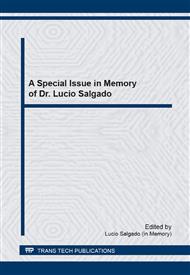p.291
p.298
p.305
p.311
p.319
p.325
p.331
p.337
p.343
Thermal Properties of a Barium Boron Silicate Glass as a Sealant for Use in Anode-Supported Solid Oxide Fuel Cells
Abstract:
The Solid oxide fuel cell is a very efficient and clean source of energy. The planar design of SOFC requires sealant at the edges of the cell to prevent fuel leakage (H2, CH4, etc) and air mixing at its working temperature (700 to 900°C). The extreme operation conditions of current cell designs involve both high temperatures and highly corrosive environments. As a consequence is necessary a material to seal the chambers of the anode and cathode along each cell unit (the anode-cathode-electrolyte and interconnects). The present work is an attempt to engineering glass compositions based on the BaO-Al2O3-SiO2-B2O3 system chosen due its thermal properties and good glass forming tendency. The glass formation or stability against crystallization and the coefficient of thermal expansion were determined by Differential Scanning Calorimeter and Dilatometric analysis, including sinterization curves. The main subject of this work is the development and selection of sealing glasses composition for SOFCs applications and also the development of new methodologies for preparation and evaluation of glass ceramics suitable for SOFC seals applications.
Info:
Periodical:
Pages:
319-324
Citation:
Online since:
September 2014
Keywords:
Price:
Сopyright:
© 2015 Trans Tech Publications Ltd. All Rights Reserved
Share:
Citation:


